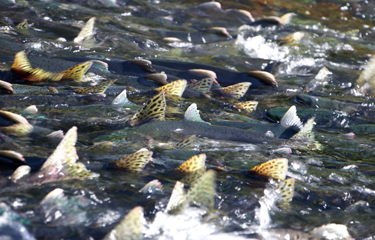OBI Seafoods and Trident Seafoods will not be opening salmon processing plants in Alaska as a result of low projected salmon returns.
OB Seafoods’ processing plant in Excursion Inlet, Alaska, will be not be processing fish for the 2021 salmon season due to a string of poor runs in the Southeast district.
And Trident’s Wrangell plant won’t open this year, with plant manager Nick Ohmer telling the Wrangell Sentinel Trident would need “to see somewhere between 40 percent and 50 percent more fish chums than were projected to return to Southeast Alaska” for the plant to open.
While all salmon species are down in the district, the Excursion Inlet plant has been especially affected by the lagging numbers of pink and chum salmon, the two main species processed at the plant. Wild chum and pink runs are down, as are returns to the nearby Douglas Island Chum and Pink (DIPAC) fish hatchery.
According to the Alaska Department of Fish and Game (ADFG), last season the commercial harvest of pink salmon in Southeast was just over eight million fish, ranking 53rd since 1962. The 2020 chum catch was under five million fish.
In a statement released to SeafoodSource, OBI Seafoods’ Public Affairs Manager Julianne Curry said these low runs have forced the company into a “difficult decision.”
“The last few years have been tough for Southeast salmon runs, with last year seeing a historic low for both pinks and chum. Our Excursion Inlet facility is reliant on overall salmon returns and also DIPAC returns, which recently hasn't produced at optimum numbers for our operation,” Curry said.
Fish typically processed in Excursion Inlet will be sent to an OBI Seafoods’ facility in Petersburg, Alaska, a plant capable of moving enough volume to keep nets in the water, according to Curry.
“All of our Southeast salmon will be processed using our Petersburg facility as our Southeast hub for this season. This allows us to centralize our operation, right-size our production, and provide additional flexibility on product forms to maximize market demand. Petersburg has ample capacity to process every pound of salmon that crosses our docks for the upcoming season, so there's no concern about fishermen having to go on limits,” Curry said.
Curry added that the while most of the Excursion Inlet employees will be moved to the Petersburg plant, the facility will remain open for services to fishermen in the remote area.
“Fishermen can continue to rely on fleet support at the Excursion Inlet plant with a full machine shop, a port engineer, gear storage, fuel sales, and spare skiffs along with fishermen laundry, showers, and the store. Around four employees will continue to work at the Excrusion Inlet plant to ensure that our fishermen's needs are met,” Curry said.
ADFG predicts a return to average ranks for pink salmon in the district in 2021, with a forecasted catch of over 28 million pink salmon, with a predicted harvest of nearly nine million chum salmon.
Curry said the 2021 closure is not permanent, the company will reevaluate the plant’s status next summer.
The village of Excursion Inlet is a remote outpost in Alaska’s Haines Borough, near the entrance of Glacier Bay National Park. It has had a functioning fish processing facility since 1891.
Not only are there fewer salmon returning to Alaska’s rivers, but those that are returning are smaller. A September 2020 study published in Nature Communications documented body size declines in chinook, sockeye, silver, and chum across the entire state of Alaska.
The bodies of commercially valuable sockeye shrank by 2 percent, silver salmon were 3 percent smaller on average, and chinook salmon shrunk by 8 percent compared to their average size before 1990, according to Curry Cunningham, one of the study’s co-authors and an assistant professor at the University of Alaska Fairbanks.
“Every sockeye, on average across the state, is worth about USD 0.50 [EUR 0.41] less,” he told The Guardian. “That’s 50 cents less per fish you’re picking out of the net.”
The study’s authors said there is evidence climate change is impacting the quality or availability of the food the salmon eat, and there is also evidence – albeit weaker – that competition with larger numbers of hatchery-raised pink salmon is a factor.
Another reason for smaller-sized salmon is because many are returning from the ocean at a younger age. The trend is also playing out around the globe, from the U.S. to Canada, Russia, and Japan, according Peter Westley of the University of Alaska Fairbanks, another of the study’s authors.
OBI Seafoods CEO Mark Palmer told Bloomberg that the smaller-sized salmon have thrown off OBI’s fish-sorting process. In the past, sockeye weighing four pounds or more comprised as much as 70 percent of the catch in Bristol Bay, but now those larger salmon are no more than half the catch, according to Palmer.
“Your yields go down a little bit with smaller fish,” he said.
Those smaller fish are also being noticed by the U.S. retail and foodservice sector.
Whole Foods Market has introduced new guidelines for purchasing salmon from wholesalers in response to the smaller-sized fish they had been receiving. And Seattle, Washington-based seafood restaurant Ivar’s is sending back undersized salmon, according to head chef Craig Breeden.
“It’s very irritating when the supplier sends it to me and I see the size of these fillets,” he told Bloomberg. “In the last eight to 10 years, the salmon sizes have started to get smaller and smaller.”
Photo courtesy of Kerrin Ingwersen/Shutterstock







